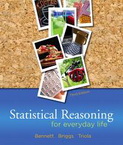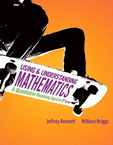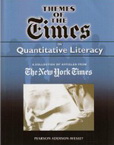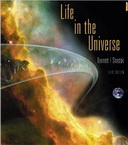“Jeffrey Bennett served as the first director of the program in Quantitative Reasoning and Mathematical Skills at the University of Colorado, where he developed the groundbreaking curriculum that became the basis of his best-selling college textbook in mathematics. He holds a PhD in astrophysics and is also the lead author of top-selling college textbooks in statistical reasoning, astronomy, and astrobiology. Math for Life is his third book for the general public, following the critically acclaimed On the Cosmic Horizon [out of print] and Beyond UFOs. He is also the author of award-winning children's books about science, including Max Goes to the Moon, Max Goes to Mars, Max Goes to Jupiter, and The Wizard Who Saved the World.” Check out Jeff Bennett's home page.
Math for Life: Crucial Ideas You Didn't Learn in School
216 pages, hc. November 2011. Roberts and Company Publishers.
Book Description:
How can we solve the national debt crisis? Should you or your child take on a student loan? Is it safe to talk on a cell phone while driving? Are there viable energy alternatives to fossil fuels? Could simple policy changes reduce political polarization? These questions may all seem very different, but they share two things in common. First, they are all questions with important implications for either personal success or our success as a nation. Second, they all concern topics that we can fully understand only with the aid of clear quantitative or mathematical thinking. In other words, they are topics for which we need math for life--a kind of math that looks quite different from most of the math that we learn in school, but that is just as (and often more) important. In Math for Life, award-winning author Jeffrey Bennett simply and clearly explains the key ideas of quantitative reasoning and applies them to all the above questions and many more. He also uses these questions to analyze our current education system, identifying both shortfalls in the teaching of mathematics and solutions for our educational future. No matter what your own level of mathematical ability, and no matter whether you approach the book as an educator, student, or interested adult, you are sure to find something new and thought-provoking in Math for Life.
Reviews:
Full marks to Jeffrey Bennett for delivering exactly what his title promises. This is not the math your teacher (probably) said you would need in adult life but never did; it's the math you know you need but likely don t have. It's not a traditional textbook; it's a how-to manual for clear thinking about the quantitative aspects of everyday life, bursting with intriguing, practical, real-life examples. I recommend it. —Keith Devlin, Ph.D., Stanford University, author of The Man of Numbers: Fibonacci's Arithmetic Revolution and The Math Gene, and the Math Guy on National Public Radio.
Sprinkled with illuminating examples, Math for Life presents issues critical to personal and national security even survival in clear and forthright terms. Underlying this important message is the obvious failure of U.S. mathematics education to meet the enormous quantitative reasoning demands of U.S. society. Jeffrey Bennett makes plain how current political and economic crises stem from this failure. —Bernard L. Madison, Professor of Mathematics, University of Arkansas
Should be required reading for every American. There's no more powerful way to equip yourself for our increasingly complex and quantitative world than to read Math for Life. Every concept is presented in a clear and engaging way. --K. Shane Goodwin, Professor of Mathematics, Brigham Young University Idaho
Table of Contents:
| Preface | vii | |
| 1 | (Don't Be) “Bad at Math” | 1 |
| 2 | Thinking with Numbers | 11 |
| 3 | Statistical Thinking | 33 |
| 4 | Managing Your Money | 65 |
| 5 | Understanding Taxes | 89 |
| 6 | The U.S. Deficit and Debt | 105 |
| 7 | Energy Math | 119 |
| 8 | The Math of Political Polarization | 147 |
| 9 | The Mathematics of Growth | 163 |
| Epilogue: Getting “Good at Math” | 183 | |
| To Learn More | 197 | |
| Acknowledgments | 199 | |
| Also by Jeffrey Bennett | 201 | |
| Index | 203 | |
| Index of Examples | 209 |
Preface
“The housing bubble. Lotteries. Cell phones and driving. Personal budgeting. The federal debt. Social Security. Tax reform. Energy policy. Global warming. Political redistricting. Population growth. Radiation from nuclear power plants.
What do all the above have in common? Each is a topic with important implications for all of us, but also a topic that we can fully understand only if we approach it with clear quantitative or mathematical thinking. In other words, these are all topics for which we need “math for life” — a kind of math that looks quite different from most of the math that we learn in school, but that is just as (and sometimes more) important.
Now, in case the word “math” has you worried for any reason, rest assured that this is not a math book in any traditional sense. You won't find any complex equations in this book, nor will you see anything that looks much like what you might have studied in high school or college mathematics classes. Instead, the focus of this book will be on what is sometimes called quantitative reasoning, which means using numbers and other mathematically based ideas to reason our way through the kinds of problems that confront us in everyday life. As the list in the first paragraph should show, these problems range from the personal to the global, and over everything in between.
So what exactly will you learn about “math for life” in this short book? Perhaps the best way for me to explain it is to list my three major goals in writing this book:
- On a personal level, I hope this book will prove practical in helping you make decisions that will improve your health, your happiness, and your financial future. To this end, I'll discuss some general principles of quantitative reasoning that you may not have learned previously, while also covering specific examples that will include how to evaluate claims of health benefits that you may hear in the news (or in advertisements) and how to make financial decisions that will keep you in control of your own life.
- On a societal level, I hope to draw attention to what I believe are oft-neglected mathematical truths that underlie many of the most important problems of our time. For example, I believe that far too few of us and far too few politicians) understand the true magnitude of our current national budget predicament, the true challenge of meeting our future energy needs, or what it means to live in a world whose population may increase by another 3 billion people during the next few decades. I hope to show you how a little bit of quantitative reasoning can illuminate these and other issues, thereby making it more likely that we'll find ways to bridge the political differences that have up until now stood in the way of real solutions.
- On the level of educational policy, I hope that this book will have an impact on the way we think about mathematics education. As I'll argue throughout the book, I believe that we can and must do a much better job both in teaching our children traditional mathematics — meaning the kind of mathematics that is necessary for modern, high-tech careers — and in teaching the mathematics of quantitative reasoning that we all need as citizens in today's society. I'll discuss both the problems that exist in our current educational system and the ways in which I believe we can solve them.
With those three major goals in mind, I'll give you a brief overview of how I've structured the book. The first chapter focuses on the general impact of societal attitudes toward math. In particular, I'll explain why I think the fact that so many people will without embarrassment say that they are “bad at math” was a major contributing factor to the housing bubble and the recent recession; I'll also discuss the roots of poor attitudes toward math and how we can change those attitudes in the future. The second and third chapters provide general guidance for understanding the kinds of mathematical and statistical thinking that lie at the heart of many modern issues and that are in essence the core concepts of “math for life.” The remaining chapters are topic-based, covering all the issues I listed above, and more; note that, while I'd like to think you'll read the book cover to cover, I've tried to make the individual chapters self-contained enough so that you could read them in any order. Finally, in the epilogue, I'll offer my personal suggestions for changing the way we approach and teach mathematics.
As an author, I always realize that readers are what make my work possible, and I thank you for taking the time to at least have a look at this book. If I've convinced you to read it through, I hope you find it both enjoyable and useful.”
Excerpts:
More excerpts on Jeff Bennets “Math for Life” web page
“Focus on quantitative reasoning. If you accept my rationale for no longer allowing algebra to fulfill the college math requirement, then the question becomes what to replace it with. To me, the answer is clear: quantitative reasoning. As you've seen throughout this book, most of the mathematical skills needed for quantitative reasoning are fairly basic, but the level of conceptual thinking can be quite advanced. This means that quantitative reasoning can be taught at a clearly collegiate level, and there is plenty to cover in a semester or even a yearlong course; this entire book contains only about 5% to 10% as much material as a quantitative reasoning course typically covers. Moreover, because quantitative reasoning is so important to modern life, it is a great disservice to make the requirement anything else. For example, some colleges have recently introduced course requirements in financial literacy while others offer courses in statistical literacy; both types of courses are clearly useful, but neither covers the breadth of topics that we've covered in this book, which means they are not by themselves enough. (Note, however, that such courses can be great options for one semester of a two-semester quantitative reasoning requirement.) Still other colleges offer courses giving students a brief introduction to some of the esoteric branches of mathematics that mathematicians study. These courses can be immensely interesting but I don't think they are covering the material that students need for their everyday lives; for that reason, I'd make such courses electives, to come after a quantitative reasoning course requirement is fulfilled.” P. 194-195
Statistical Reasoning for Everyday Life
By Jeffrey Bennett, Bill Briggs and Mario Triola. 512 pages, pb. 3rd edition 2008. 2nd edition 2003. Addison Wesley.
Based on Statistical Reasoning for Ever by Jeffrey O. Bennett (2002).
Table of Contents:
-
Speaking of Statistics
- What Is/Are Statistics?
- Sampling
- Types of Statistical Studies
- Should You Believe a Statistical Study?
Focus on Sociology: Does Daycare Breed Bullies?
Focus on Public Health: Is Your Lifestyle Healthy?
-
Measurement in Statistics
- Data Types and Levels of Measurement
- Dealing with Errors
- Uses of Percentages in Statistics
- Index Numbers
Focus on Politics: Who Benefits from a Tax Cut?
Focus on Economics: Is our Standard of Living Improving?
-
Visual Displays of Data
- Frequency Tables
- Picturing Distributions of Data
- Graphics in the Media
- A Few Cautions About Graphics
Using Technology
Focus on History: Can War Be Described with a Graph?
Focus on Environment: How Can We Visualize Global Warming?
-
Describing Data
- What Is Average?
- Shapes of Distributions
- Measures of Variation
- Statistical Paradoxes
Using Technology
Focus on The Stock Market: What’s Average About the Dow?
Focus on Economics: Are the Rich Getting Richer?
-
A Normal World
- What Is Normal?
- Properties of the Normal Distribution
- The Central Limit Theorem
Using Technology
Focus on Education: What Can We Learn from SAT Trends?
Focus on Psychology: Are We Smarter than Our Parents?
-
Probability in Statistics
- The Role of Probability in Statistics: Statistical Significance 226
- Basics of Probability
- Probabilities with Large Numbers
- Ideas of Risk and Life Expectancy
- Combining Probabilities (Supplementary Section)
Focus on Social Science: Are Lotteries Fair?
Focus on Law: Is DNA Fingerprinting Reliable?
-
Correlation and Causality
- Seeking Correlation
- Interpreting Correlations
- Best-Fit Lines and Prediction
- Search for Causality
Using Technology
Focus on Education: What Helps Children Learn to Read?
Focus on Environment: What Causes Global Warming?
-
From Samples to Populations
- Sampling Distributions
- Estimating Population Means
- Estimating Population Proportions
Using Technology
Focus on History: Where Did Statistics Begin?
Focus on Literature: How Many Words Did Shakespeare Know?
-
Hypothesis Testing
- Fundamentals of Hypothesis Testing
- Hypothesis Tests for Population Means
- Hypothesis Testing: Population Proportions
Using Technology
Focus on Health & Education: Will Your Education Help You Live Longer?
Focus on Agriculture: Are Genetically Modified Foods Safe?
-
Tests, Two-Way Tables, and ANOVA
- Distribution for Inferences about a Mean
- Hypothesis Testing with Two-Way Tables
- Analysis of Variance (One-Way ANOVA)
Using Technology
Focus on Criminology: Can You Tell a Fraud When You See One?
Focus on Education: What Can a Fourth-Grader Do with Statistics?
Preface
Supplements
To the Student: How to Succeed in Your Statistics Course
Applications Index
Epilogue: A Perspective on Statistics
Appendix A: z-Score Tables
Appendix B: Table of Random Numbers
Suggested Readings
Credits
Glossary
Answers
Index
Themes of the “Times”: Quantitative Literacy
By Jeffrey Bennett. 4th edition 2007.
This collection of engaging articles from The New York Times explores a wide range of quantitative topics appearing in recent news items and stories. Articles are correlated to chapters in Using and Understanding Mathematics: A Quantitative Reasoning Approach, and chapter-specific references make it easy for you to relate each article to the textbook. A series of follow-up questions are also included for homework or class discussion.
Using and Understanding Mathematics: A Quantitative Reasoning Approach
By Jeffrey Bennett and William Briggs. 5th edition 2010 Pearson (Addison-Wesley)
Using and Understanding Mathematics: A Quantitative Reasoning Approach increases students‘ mathematical literacy so that they better understand the mathematics used in their daily lives.
Ideal for courses that emphasize quantitative reasoning, Bennett and Briggs prepare students to use math effectively to make better decisions throughout their lives. Contents are organized with that in mind, with engaging coverage in sections like Taking Control of Your Finances, Dividing the Political Pie, and a full chapter about Mathematics and the Arts.
This Fifth Edition offers new hands-on Activities for use with students in class, new ways for students to check their understanding through Quick Quizzes, and a new question type in MyMathLab that applies math to recent events in the news. In addition, the authors increase their coverage of consumer math, and provide a stronger emphasis on technology through new Using Technology features and exercises. The new Insider's Guide provides instructors with tips and ideas for effective use of the text in teaching the course.
Table of Contents
Preface
Prologue
Literacy for the Modern World.
-
Logic and Problem Solving
-
Thinking Critically
- Recognizing Fallacies
- Propositions and Truth Values
- Sets and Venn Diagrams
- Analyzing Arguments
- Critical Thinking in Everyday Life
-
Thinking Critically
-
Quantitative Information in Everyday Life.
-
Approaches to Problem Solving
- The Problem-Solving Power of Units
- Standardized Units: More Problem-Solving Power
- Problem-Solving Guidelines and Hints
-
Numbers in the Real World
- Uses and Abuses of Percentages
- Putting Numbers in Perspective
- Dealing with Uncertainty
- Index Numbers: The CPI and Beyond
- How Numbers Deceive: Polygraphs, Mammograms, and More
-
Managing Money
- Taking Control of Your Finances
- The Power of Compounding
- Savings Plans and Investments
- Loan Payments, Credit Cards, and Mortgages
- Income Taxes
- Understanding the Federal Budget
-
Approaches to Problem Solving
-
Probability and Statistics
-
Statistical Reasoning
- Fundamentals of Statistics
- Should You Believe a Statistical Study?
- Statistical Tables and Graphs
- Graphics in the Media
- Correlation and Causality
-
Putting Statistics to Work
- Characterizing Data
- Measures of Variation
- The Normal Distribution
- Statistical Inference
-
Probability: Living with the Odds
- Fundamentals of Probability
- Combining Probabilities
- The Law of Large Numbers
- Assessing Risk
- Counting and Probability
-
Statistical Reasoning
-
Modeling
-
Exponential Astonishment
- Growth: Linear versus Exponential
- Doubling Time and Half-Life 8C Real Population Growth
- Logarithmic Scales: Earthquakes, Sounds, and Acids
-
Modeling Our World
- Functions: The Building Blocks of Mathematical Models
- Linear Modeling 9C Exponential Modeling
-
Modeling with Geometry
- Fundamentals of Geometry
- Problem Solving with Geometry
- Fractal Geometry
-
Exponential Astonishment
-
Further Applications
-
Mathematics and the Arts
- Mathematics and Music
- Perspective and Symmetry
- Proportion and the Golden Ratio
-
Mathematics and Politics
- Voting: Does the Majority Always Rule?
- Theory of Voting
- Apportionment: The House of Representatives and Beyond
- Dividing the Political Pie
-
Mathematics and the Arts
Credits
Answers
Index








